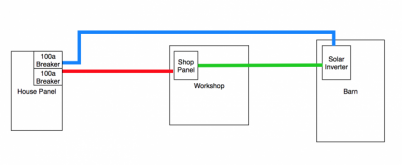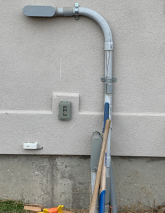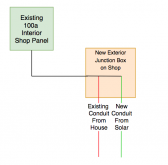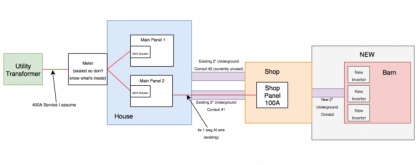Hi Everyone,
I am trying to plan for a 25kw solar installation. Currently I have a 100a circuit from by house to my workshop (separate building).
There's a 100a panel in the workshop. I am going to be adding a barn and the solar panels will go on the
barn. The inverter(s) will be in the barn as well.
In the diagram below the existing wiring is in red. Typically an inverter would connect to the house panel with its own
breaker as shown in blue. Rather than running an entirely new circuit (in blue) I am wondering if I can just bring the inverter
output to the shop panel (in green) which then eventually goes to the house panel using existing cable (in red). Logistically
this is much easier to accomplish. I need to verify the current rating on the existing circuit. I'm also concerned that, at
208v, 25kw is 120 amps so it may not work at all if the existing circuit only supports 100a.

What do you think? Is this possible?
Victor
I am trying to plan for a 25kw solar installation. Currently I have a 100a circuit from by house to my workshop (separate building).
There's a 100a panel in the workshop. I am going to be adding a barn and the solar panels will go on the
barn. The inverter(s) will be in the barn as well.
In the diagram below the existing wiring is in red. Typically an inverter would connect to the house panel with its own
breaker as shown in blue. Rather than running an entirely new circuit (in blue) I am wondering if I can just bring the inverter
output to the shop panel (in green) which then eventually goes to the house panel using existing cable (in red). Logistically
this is much easier to accomplish. I need to verify the current rating on the existing circuit. I'm also concerned that, at
208v, 25kw is 120 amps so it may not work at all if the existing circuit only supports 100a.

What do you think? Is this possible?
Victor





